
The Elizabeth Arkham Asylum for the Criminally Insane, commonly referred to as Arkham Asylum, is a fictional psychiatric hospital/prison, named after the city of Arkham which appeared first in the stories of H. P. Lovecraft, and later appearing in American comic books published by DC Comics, commonly in stories featuring the superhero Batman. It first appeared in Batman #258, written by Dennis O'Neil with art by Irv Novick. The asylum serves as a (forensic) psychiatric hospital for the Gotham City area, housing patients who are criminally insane, as well as select prisoners with unusual medical requirements that are beyond a conventional prison's ability to accommodate. Its high-profile patients are often members of Batman's rogues gallery.

The Scarecrow is a supervillain appearing in American comic books published by DC Comics. Created by Bill Finger and Bob Kane, the character first appeared in World's Finest Comics #3. He has become one of the most enduring enemies of the superhero Batman and belongs to the collective of adversaries that make up his rogues gallery.
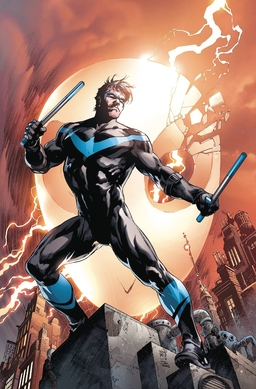
Nightwing is the name of several superheroes appearing in American comic books published by DC Comics. The most prominent is Dick Grayson, who takes the name when he leaves his role as Batman's partner and sidekick Robin in his adulthood.

Richard John "Dick" Grayson is a superhero appearing in American comic books published by DC Comics, commonly in association with Batman, Teen Titans and Justice League. Created by writer Bill Finger and artist Bob Kane, he first appeared in Detective Comics #38 in April 1940 as the original and most popular incarnation of Robin, Batman's crime-fighting partner. In Tales of the Teen Titans #44, the character, after becoming a young adult, retires his role as Robin and assumes the superhero persona of Nightwing. Grayson has donned the cape and cowl to replace Bruce Wayne as Batman. His most notable spell as Batman follows Bruce Wayne's supposed death in Final Crisis, and sees Grayson adopt Damian Wayne as his Robin.

Alfred Thaddeus Crane Pennyworth, originally Alfred Beagle and commonly known simply as Alfred, is a fictional character appearing in American comic books published by DC Comics, most commonly in association with the superhero Batman.

Bane is a supervillain appearing in American comic books published by DC Comics. Created by writer Chuck Dixon and artist Graham Nolan, he made his debut in Batman: Vengeance of Bane #1. Bane is usually depicted as a dangerous adversary of the superhero Batman, and belongs to the collective of enemies that make up Batman's rogues gallery. Possessing a mix of brute strength and exceptional intelligence, Bane is often credited as the only villain to have "broken the bat", defeating him both physically and mentally. Bane went on to kill Alfred Pennyworth in 2019 during the City of Bane storyline. He is the son of another Batman enemy, King Snake and has a clone/daughter named Vengeance, introduced in 2021.
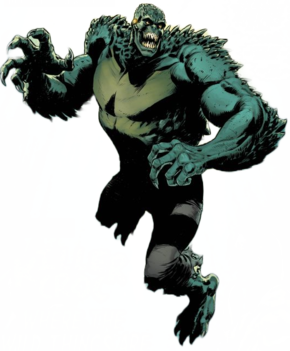
Killer Croc is a supervillain appearing in American comic books published by DC Comics. Created by Gerry Conway, Don Newton and Gene Colan, the character was introduced in Batman #357. He has become one of the most enduring enemies of the superhero Batman and belongs to the collective of adversaries that make up his rogues gallery.
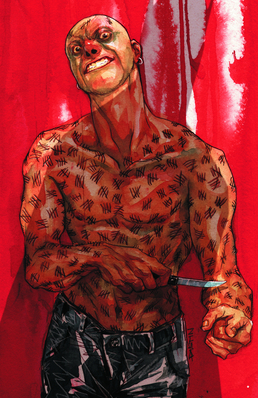
Victor Zsasz, also known as Mr. Zsasz or simply Zsasz, is a supervillain appearing in comic books published by DC Comics. The character first appeared in Batman: Shadow of the Bat #1. He is a sadomasochistic and psychopathic serial killer who carves a tally mark onto himself for each of his victims. A recurring adversary of the superhero Batman, Zsasz belongs to the collective of enemies that make up Batman's rogues gallery.

The Ventriloquist is the name of multiple supervillains appearing in American comic books and other media published by DC Comics. All of the Ventriloquist's versions are enemies of Batman, belonging to the collective of adversaries that make up Batman's rogues gallery.
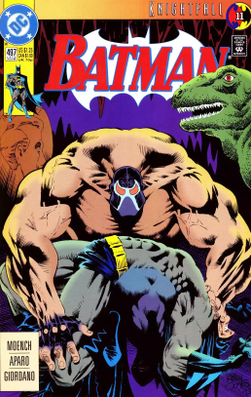
"Knightfall" is a 1993–1994 Batman story arc published by DC Comics. It consists of a trilogy of storylines that ran from 1993 to 1994, consisting of "Knightfall", "Knightquest", and "KnightsEnd".

Firefly is a supervillain appearing in American comic books published by DC Comics. Created by France Herron and Dick Sprang, he made his debut in Detective Comics #184. Initially portrayed as a criminal who utilized lighting effects to commit robberies, Firefly was later reimagined as a sociopathic pyromaniac with an obsessive compulsion to start fires following Crisis on Infinite Earths' reboot of the DC Universe in the 1980s. This darker depiction of the character has since endured as one of the superhero Batman's most recurring enemies and belongs to the collective of adversaries that make up his central rogues gallery.

Hush is a supervillain appearing in American comic books published by DC Comics. Created by Jeph Loeb and Jim Lee, the character first appeared in Batman #609 in January 2003 as part of the twelve-issue storyline Batman: Hush. Hush serves as a criminal foil to the superhero Batman and belongs to the collective of adversaries that make up his rogues gallery.

Calendar Man is a supervillain appearing in American comic books published by DC Comics, as an enemy of the superhero Batman, belonging to the collective of adversaries that make up Batman's rogues gallery. Calendar Man is known for committing crimes that correspond with holidays and significant dates. He often wears costumes to correlate with the date of the designated crime. His name, in itself, is a joke, referencing both the Julian and Gregorian calendars. In his debut, the character was presented as a joke villain, but in later years, writers developed Calendar Man as a dark, disturbed criminal who toys with Batman.
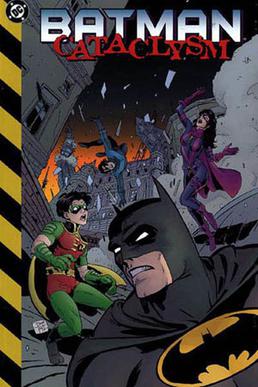
Cataclysm is an 18-chapter DC Comics crossover story arc that ran through the various Batman family comics from March to May 1998. The plot of the storyline centers on Gotham City being hit by a massive earthquake, the epicenter of which is less than a mile from Wayne Manor. In the wake of the destruction, Batman and his allies join the frantic rescue efforts around the devastated city, which soon spirals into chaos. This story arc would act as a catalyst for the Batman comics and its spin-off titles, signaling the beginning of nearly two years of storylines that would spring forth in the earthquake's aftermath, culminating in the year-long Batman: No Man's Land saga. Cataclysm itself takes place a short time after the events of Batman: Contagion and Batman: Legacy, two previous crises which also nearly resulted in Gotham City's destruction.

Cornelius Stirk is a fictional character appearing in DC Comics. He is a cannibalistic supervillain with the ability to cause fear or hallucinations through telepathy and appears as a recurring adversary of Batman.

"The Last Arkham" was a four-part Batman story arc that started the Batman: Shadow of the Bat comic book series in mid-1992. The storyline began in Batman: Shadow of the Bat #1, and finished in Batman: Shadow of the Bat #4. DC Comics later compiled the four issues into a trade paperback in 1995. The comic was written by Alan Grant and drawn by Norm Breyfogle and was responsible for the introduction of several new characters into the Batman universe.
This article is about the publication history of the DC Comics fictional character Dick Grayson, who has been portrayed in comic books alternatively as Robin, Nightwing, and Batman.
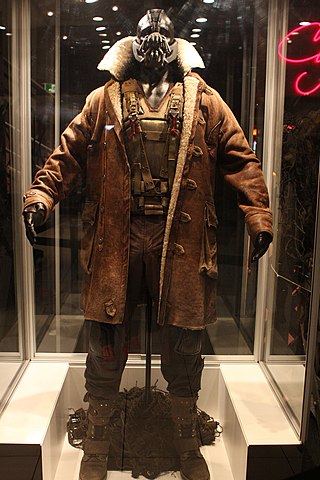
Bane was originally a comic book character and Batman's adversary, but has appeared in several other forms of media. He has been portrayed in live action by Robert Swenson in Batman & Robin, Tom Hardy in The Dark Knight Rises, and Shane West in Gotham. Henry Silva, Joaquim de Almeida, Ron Perlman, Clancy Brown, Michael Dorn, Danny Trejo, Héctor Elizondo, Carlos Alazraqui, Fred Tatasciore, Jason Liebrecht, Steve Blum, JB Blanc, Doug Benson, James Adomian, and Peter Marinker have all provided voice work for the character.
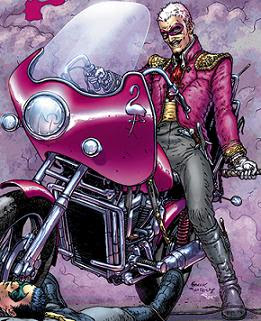
Flamingo is a fictional supervillain appearing in American comic books published by DC Comics, commonly as an adversary of Batman.
Jeremiah Arkham is a fictional supervillain and the head of the Arkham Asylum in DC Comics, created by Alan Grant. Arkham was created in 1992, and slowly "lost his mind" during his time in the Arkham Asylum, subsequently becoming the second Black Mask. Though described as a sadist, Arkham seems to believe his intentions are for the benefit of his patients.


















